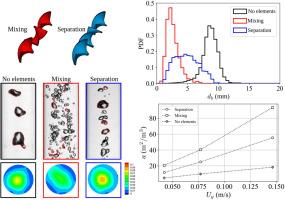气液管式反应器过程强化多模态测量技术的先进表征
IF 3.9
3区 工程技术
Q3 ENERGY & FUELS
Chemical Engineering and Processing - Process Intensification
Pub Date : 2025-10-01
DOI:10.1016/j.cep.2025.110570
引用次数: 0
摘要
在这项工作中,我们研究了在垂直管道中紊流气液混合和分离,该管道配备了Kenics静态元件,用于连续操作中的过程强化应用。该研究基于电阻层析成像、数字图像分析和压降测量,以提供两相系统的全面表征。利用灵敏度共轭梯度法和线性反投影法两种不同的重建算法,从电压差测量中计算出气体体积分数分布。灵敏度共轭梯度算法在管壁附近提供了更好的分辨率,并能清晰地检测出螺旋元件典型的不对称模式。从数字图像分析中得到的气泡大小分布可以根据静态元素的方向来评估它们在提供混合和分离方面的有效性。采用光学和层析技术测量气相的空间分布,得到了平均气含率,得到了相似的结果。总体而言,实验数据分析表明,可以通过平衡能耗和气体分散来确定最佳性能。这些发现为需要有效混合和控制分离的直列反应器的设计提供了有价值的见解。本文章由计算机程序翻译,如有差异,请以英文原文为准。

Advanced characterization with multimodal measurement techniques for process intensification in gas–liquid tubular reactors
In this work we investigate turbulent gas–liquid mixing and separation in a vertical pipeline equipped with Kenics Static Elements for process intensification applications in continuous operations. The investigation is based on Electrical Resistance Tomography, digital image analysis and pressure drop measurements to provide a comprehensive characterization of the two-phase system. The gas volume fraction distribution is calculated from the voltage difference measurement using two different reconstruction algorithms: the Sensitivity Conjugate Gradient and the Linear Back Projection. The Sensitivity Conjugate Gradient algorithm provides better resolution near the pipe wall and a clear detection of the asymmetric patterns typical of the helical elements. The bubble size distributions obtained from digital image analysis allow to assess the effectiveness of the static elements in providing mixing and separation, depending on their orientation. The spatial distributions of the gas phase measured by the optical and the tomographic techniques are adopted to obtain the average gas hold-up leading to similar results. Overall, the experimental data analysis demonstrates that optimal performance can be determined by balancing energy consumption and gas dispersion. The findings provide valuable insights for the design of in-line reactors where both efficient mixing and controlled separation are required.
求助全文
通过发布文献求助,成功后即可免费获取论文全文。
去求助
来源期刊
CiteScore
7.80
自引率
9.30%
发文量
408
审稿时长
49 days
期刊介绍:
Chemical Engineering and Processing: Process Intensification is intended for practicing researchers in industry and academia, working in the field of Process Engineering and related to the subject of Process Intensification.Articles published in the Journal demonstrate how novel discoveries, developments and theories in the field of Process Engineering and in particular Process Intensification may be used for analysis and design of innovative equipment and processing methods with substantially improved sustainability, efficiency and environmental performance.

 求助内容:
求助内容: 应助结果提醒方式:
应助结果提醒方式:


